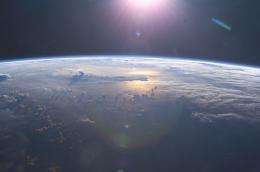New understanding of Earth's lithosphere-asthenosphere boundary beneath the Pacific Ocean

Scientists have long speculated about why there is a large change in the strength of rocks that lie at the boundary between two layers immediately under Earth's crust: the lithosphere and underlying asthenosphere. Understanding this boundary is central to our knowledge of plate tectonics and thus the formation and evolution of our planet as we know it today. A new technique for observing this transition, particularly in the portion of Earth's mantle that lies beneath the Pacific Ocean basin, has led Carnegie and NASA Goddard scientist Nick Schmerr to new insight on the origins of the lithosphere and asthenosphere. His work is published March 23 in Science.
The lithosphere-asthenosphere boundary, or LAB, represents the transition from hot, convecting mantle asthenosphere to overlying cold and rigid lithosphere. The oceanic lithosphere thickens as it cools over time, and eventually sinks back into the mantle at Earth's so-called subduction zones.
Studies of seismic waves traveling across the LAB show higher wave speeds in the lithosphere and lower speeds in the asthenosphere. In some regions, seismic waves indicate an abrupt 5 to 10% decrease in wave speeds between 35 and 120 km depth, forming a boundary known as the Gutenberg discontinuity. In many cases, the depth of the Gutenberg discontinuity is roughly coincident with the expected depth of the LAB, leading to the suggestion that the two boundaries are closely inter-related.
However, temperature alone cannot fully explain the abrupt change in the mechanical and seismic properties that have been observed at the Gutenberg discontinuity. This has led many scientists to suggest that other factors--such as the presence of molten rock, water, and/or a decrease in the grain size of minerals--may also play important roles.

Older techniques made imaging seismic discontinuities shallower than 100 kilometers quite difficult, and regions beneath the oceans could only be accessed where seismic stations were installed on ocean islands or by deploying ocean bottom seismometers, giving an incomplete picture of where the Gutenberg occurs beneath the Pacific Ocean.
But an innovative observation technique—one that incorporates seismic waves that sample beneath remote regions of the Earth at higher frequencies, and new signal processing techniques--enabled Schmerr to hone in on the Gutenberg discontinuity.
He discovered that the seismic discontinuity is not a Pacific-wide phenomenon, but rather only detectable beneath regions with recent surface volcanism. He also found the Gutenberg appears to become deeper beneath older crust, confirming the discontinuity is, indeed, related to the LAB.
Schmerr proposes that the Gutenberg is formed by partially molten rock produced in the asthenosphere that collects and ponds at the base of the lithosphere. Decompression of hot rock at small-scale upwellings or hot mantle plumes is responsible for generating the melt. Plumes will thermally reheat the lithosphere, making it shallower than would be expected underneath older crust.
"The really interesting part of this work is that it confirms partially molten rock is not present throughout in the asthenosphere of Earth," Schmerr said. "This significantly narrows the range of possible mechanisms that give rise to the low viscosity of the asthenosphere. This means plate tectonics are enabled on Earth because of mantle composition and or grain size, not necessarily the presence of melt."
More information: www.sciencemag.org/content/335/6075/1480.abstract
Provided by Carnegie Institution


















